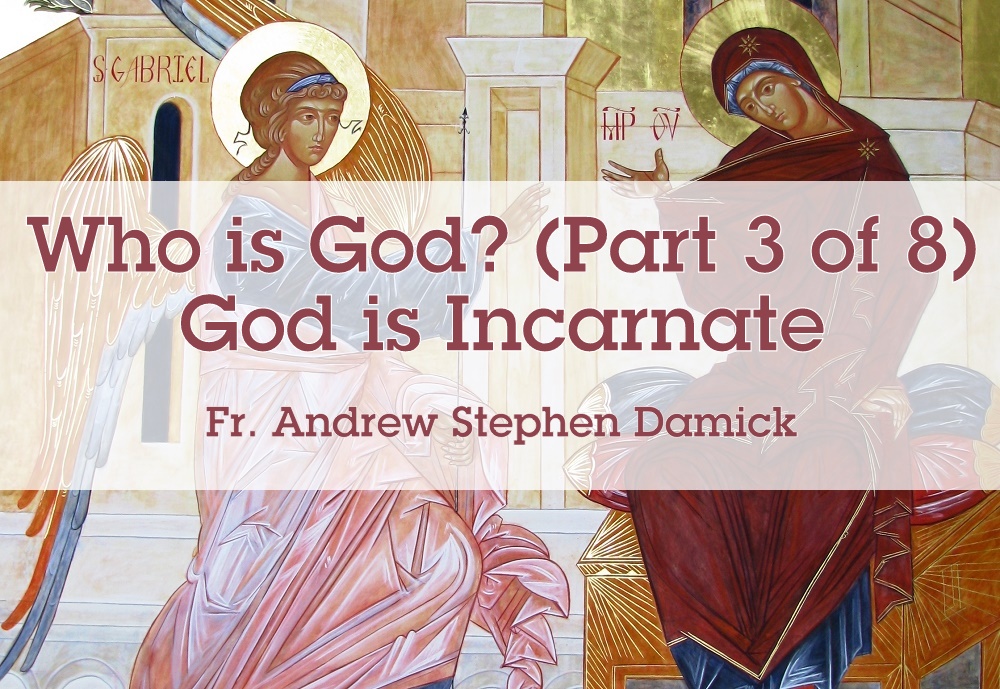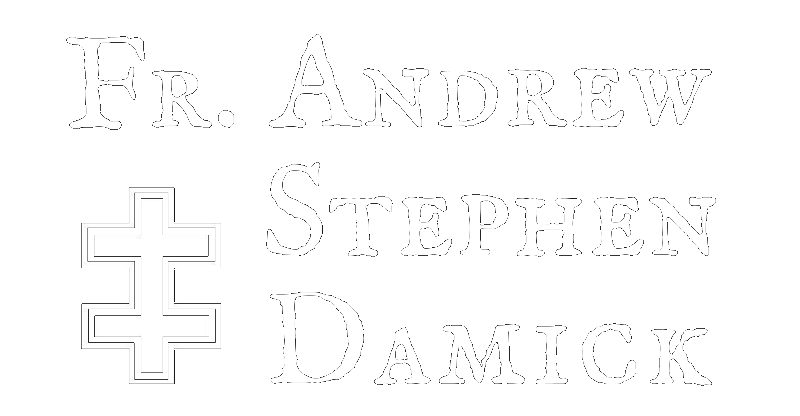
Sunday of Orthodoxy, March 20, 2016
Hebrews 11:24-26, 32-40; John 1:43-51
Rev. Fr. Andrew Stephen Damick
In the Name of the Father and of the Son and of the Holy Spirit, one God. Amen.
Today is our third of eight meditations where we ask, “Who is God?” Knowing God is how Jesus defined eternal life (John 17:3), so we keep asking this question, and we keep exploring different answers.
Today on the liturgical calendar is called the Sunday of the Triumph of Orthodoxy, a commemoration which refers to the return of icons to the churches in the ninth century, after many decades of iconoclasm. Iconoclasm is a heresy, the heresy which says that icons should not be permitted in churches, and it was officially condemned by the Church at the Seventh Ecumenical Council in AD 787.
It is the reason that iconoclasm was condemned as a heresy, what icons say about our faith, that is the key to answering our question today. What is that reason? What do the icons say? Icons are a witness to the incarnation of the Son of God. They say that He can be depicted—indeed, that He should be depicted. So, today the answer to our question, “Who is God?” is this: “God is incarnate.”
There are icons of many saints and scenes from Scripture and Church history, of course, but they all point back to one icon, the icon that is the reason for the rest of them—the icon of Jesus Christ. If we can make icons of Jesus, then the rest make sense. If not, then the rest don’t make sense, either.
The reason why icons of Jesus Christ are not only permitted but actually necessary, so necessary that rejecting them is considered a heresy, is that they make this simple statement: We can see God.
This might seem obvious now, but we have to understand how stunning that claim was when Jesus came on the scene in the first century. And to understand that, we have to know how the world understood God up to that point.
For pagan polytheists, there was no one god over all. There were many gods, who all had their own various concerns, many of them petty and not very nice. Those gods did sometimes become visible, according to their stories. But you didn’t really see the god. You saw an avatar, or at best, a god appearing in the shape of some other thing, perhaps human-looking, perhaps not.
But for Jews and for the monotheists that had developed among the pagans, there was only one God. But that God could not be seen, not ever. That God was the creator and was above and beyond all materiality. He wouldn’t stoop to become visible in our world. Physical matter had nothing to do with God. A God Who could be seen was regarded as not truly God.
But the Christian claim of the Son of God becoming incarnate—that was truly new. This was not like the pagan gods of old, because this was no avatar. God wasn’t coming in a disguise, merely in the shape of a person or an animal or a fantastical beast. No, this was God coming with His own humanity, a humanity He had taken truly for Himself. The human body of Jesus Christ was not a temporary disguise. This human body was truly His own. When the Son of God became incarnate, we were able to say that God now has a body.
And to say that God has a body, well, that was truly scandalous both to Jews and to the pagan monotheists who followed in the tradition of philosophers like Plato. That just sounds crazy. How could God have a body? How could the God Who is so beyond all of this lowly, gross physicality have a body, of all things? A body, with its limitations, its smells, its feelings, its fragility? No way. Not possible.
But, yes. Possible. Imperative, even. God became man. The Son of God, the Second Person of the Holy Trinity, begotten before all ages of the Father, the Creator of the universe, the One Who is the image of the invisible God, the One according to Whom mankind was made—this God of all became human. He took a human body, a human soul, a human mind and human emotions. They are His own.
And they are His own permanently. The Incarnation was not a temporary phenomenon. It was a thundercrack that ripped apart reality itself and electrified it forever. The uncreated One Who was completely unlike anything created crossed over into our created world. And He not only entered it but became truly part of it. He is both uncreated and created at the same time—two natures in one divine Person. He is fully God and fully man, with all that those words mean and all that they point to but cannot say.
This is core, fundamental, critical Christian doctrine. If you do not believe this, then you are not Christian. You are something else. There is no Christianity without believing in the God-man Jesus Christ.
Besides being a required belief for what it means to be Christian, why do we have to believe this? What difference does the Incarnation really make for us? Why do we answer this question “Who is God?” with the answer “God is incarnate”?
In our brokenness, our incompleteness—our sin—there is only one way for us to be healed, to be saved. We have to have life brought back to us. But there is nothing in this created world that can do that. We can seek for it everywhere, and people do. They go looking for life in relationships, in achievements, in food, in education, in sex, in drugs, in self-help, in working out, in experiences, etc., etc. But all those things, as good as they may feel, are just temporary. They wear out. They grow old. They distort. They can never satisfy. They are not life.
If we want to be healed, we have to get life. And the only source of life that is true life is nothing created. We have to have what is uncreated. We have to have access to God. We have to get that divine life charged back into our lifeless souls, to electrify and energize us again so that we can really live, both now and in eternity after the resurrection.
But there’s a problem. What is created—that’s us—cannot actually touch what is uncreated—that’s God. He is totally unlike us. And the communion that He created us for was broken when Adam and Eve fell into sin. And we make it worse when we sin ourselves.
So this is how the Incarnation works: In one divine Person, our Lord Jesus Christ, is both created humanity and uncreated divinity.
“Come and see,” Philip says to Nathanael in today’s Gospel. Why? Why can he say that? He can say “Come and see,” because the God-man is a man. You see, as long as God was not incarnate, there was nothing to look at. But He is a man, so we can see Him!
This is why the Incarnation matters so very much to us. When He became man, He provided us a bridge to God—His own humanity. That chasm between God and man was bridged by His own human body and soul. Thus, through His humanity, we access His divinity. We touch that human body, the human body of God, and when we touch it, we are touching God Himself.
The Incarnation is so very central to us. Without it, none of this would matter. Without it, there is no good news, no salvation, no Church, no eternal life. God would have remained invisible to us, unknown. The Father would not have been revealed to us by the Son. And we would still be dead in our trespasses and sins.
But with the Incarnation! Yes, there is now so much for us.
Today, we ask: “Who is God?” And today, we answer: “God is incarnate.”
To the Incarnate God Jesus Christ therefore be all glory, honor and worship, with His Father and the Holy Spirit, now and ever, and unto ages of ages. Amen.




Father, your blessing. I just wanted to humbly mention that I love this series you’re doing, and I hope you might consider publishing it as a booklet some day. I think they would be very beneficial, and I would love to be able to hand them out to friends. Thanks.
So far,so good! I wasn’t going to even comment, however, the last post from “George” seemed like such a great idea, that I had to chime in and say, ” I second that notion”! May God grant us all a blessed Lent.
Father Andrew,
I am a seeking Protestant (just made that one up!) Just a question about icons… I went to an Orthodox Monastery and one of the nuns told me that St. Luke was the first iconagrapher. (May have made that one up too, can’t remember!) I think I had asked her why the icon faces look so much the same. And that is my question for you also. Are the icons actual representations? If so, why are most of their faces so elongated (compared to people now?) Or is there a reason that they look like that? I know it’s not an important question in the scheme of life, but I have wondered about it ever since I saw my first icon. Since icons are one of the things that hold me back from Orthodoxy, I sure would like to know.
Thank you!
Rebecca
It is true that traditionally Luke is understood to be the first iconographer. This is not a dogma of the Orthodox faith, however.
As for whether icons are “actual representations,” I think it would be better to say that, in most cases, they do have a relationship with the actual appearance of the saint in question. We can’t know that for certain prior to the invention of the photograph, of course (suffice it to say that modern saints’ icons often are based on photographs).
But concerning why the faces tend to be elongated, that is really a stylistic question rather than a defect in terms of trying to reproduce someone’s exact appearance. That is not the purpose of icons, in any event. I have been told (and I am no iconographer or even iconologist, so caveat lector) that the unreality is deliberate. You’ll no doubt notice that there is a distortion of sorts with buildings, etc., in icons. This has been explained to me as being for the purpose of indicating an encounter with spiritual reality. Icons’ purpose is not photographic but spiritual.
The same really is true of texts, of course. They cannot exactly describe something, and spiritual texts’ purpose is not to give a historical record, in any event, but rather to provoke faith in Jesus Christ.